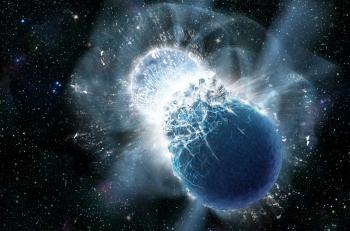Using a range of detectors developed with the participation of the CEA, physicists at CEA-Irfu have scrutinized the region from which the gravitational wave was detected on August 17, 2017 by LIGO-VIRGO facilities. Unlike the four previous detections of waves of the same type discovered since 2015, this new vibration of space, called GW170817, is of different origin. It does not result from the fusion of two black holes but of two densest known stars, the neutron stars.
Thanks to the INTEGRAL satellite in orbit, the astrophysicists of the Department of Astrophysics-AIM Laboratory (CEA, CNRS, Univ Paris Diderot) were able to show that the wave GW170817 was accompanied by a gamma burst, a brief emission of gamma rays emitted just 2 seconds after the fusion of the two stars. By pointing in record time one of the giant telescopes of the VLT (Chile), they also participated in the study of the visible light emission that followed the fusion, showing in particular that this light was not polarized.
Physicists from the Department of Particle Physics of CEA-Irfu also analyzed the data obtained by the ANTARES experiments for neutrino and H.E.S.S. for the search for very high energy gamma rays, showing that the GW170817 wave did not provide detectable emission.
The study of this new phenomenon, never observed directly so far, offers many exciting perspectives for astrophysics as the possibility of better understanding the origin of the heavy elements of the Universe and even the ability to measure in a complete independent way the rate of expansion of the Universe.
All of these outstanding results are published in a series of articles presented in the journals Nature, Astrophysical Journal and Physical Review Letters on October 16, 2017.
For more information : see the French version
• Structure and evolution of the Universe
• The Astrophysics Division (DAp) • The Particle Physics Division
• High Energy Cosmic Phenomena Research Laboratory • Astroparticles
• Antares, a high energy neutrino telescope • HESS • INTEGRAL




